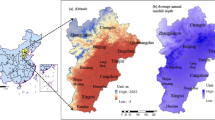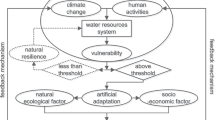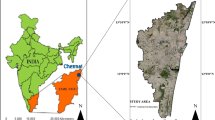Abstract
Rapid population growth and increased economic activity impose an urgent challenge on the sustainability of water resources in Beijing. Water resources system is a complex uncertain system under climate change which is of vulnerability. But water resources system vulnerability research is relatively weak. In this study, we present a multifunctional hierarchy indicator system for the performance evaluation of water resources vulnerability (WRV) under climate change. We established an evaluation model, i.e., analytic hierarchy process combining set pair analysis (AHPSPA) model, for assessing WRV, in which weight is determined by the analytic hierarchy process (AHP) method and the evaluation degrees are determined by the set pair analysis (SPA) theory. According to the principle of scientificalness, representative, completeness and operability, the index systems and standard of water resources vulnerability evaluation are established based on the analysis of sensibility and adaptability which include five subsystems: climate change, water resources change, social and economic infrastructure, water use level and water security capability. The AHPSPA model is used to assess water resource vulnerability in Beijing with 26 indexes under eight kinds of future climate change scenarios. Certain and uncertain information quantity of the WRV is calculated by connection numbers in the AHPSPA model. Results show that the WRV of Beijing is in the middle vulnerability (3 or III) under above-mentioned different climate change scenarios. The uncertain information is between 37.77 and 39.99 % in the WRV evaluation system in Beijing. Compared with present situation, the WRV will become better under scenario I and III and will become worse under scenario II, scenario IV, scenario representative concentration pathways (RCP)2.6, scenario RCP4.5, scenario RCP6.0 and scenario RCP8.5. In addition, we find that water resources change and water use level factors play more important role in the evaluation system of water resource vulnerability in Beijing. Finally, we make some suggestions for water resources management of Beijing.







Similar content being viewed by others
References
Chang CC et al (2014) Sustainability. Water Env Res 86(10):1354–1386
Chau KW (2007a) Reliability and performance-based design by artificial neural network. Adv Eng Softw 38(3):145–149
Chau KW (2007b) An ontology-based knowledge management system for flow and water quality modelling. Adv Eng Softw 38(3):172–181
Chen W et al (2006) Intelligent manipulation and calibration of parameters for hydrological models. Int J Env Pollut 28(3–4):432–447
Chen L et al (2014) An interval-deviation approach for hydrology and water quality model evaluation within an uncertainty framework. J Hydrol 509:207–214
Cheng CT et al (2005) Long-term prediction of discharges in manwan reservoir using artificial neural network models. Lect Notes Comput Sci 3498:1040–1045
Chu A et al (1979) A comparison of two methods for determining the weights of belonging to fuzzy sets. J Optim Theory Appl 27:531–538
Escobar H et al (2015) Drought triggers alarms in Brazil’s biggest metropolis. Science 347(6224):812
Hall JW et al (2014) Coping with the curse of freshwater variability. Science 346(6208):429–430
He J et al (2014) Spatiotemporal variation of meteorological droughts based on daily comprehensive drought index in Haihe River Basin. China Nat Hazards 71(10):3–21
Iliadis LS, Maris F (2007) An artificial neural network model for mountainous water-resources management: the case of cyprus mountainous watersheds. Env Modell Softw 22:1066–1072
Intergovernmental Panel on Climate Change (IPCC) (2012) Managing the risks of extreme events and disasters to advance climate change adaptation. A special report of working groups I and II of the intergovernmental panel on climate change. Cambridge University Press, Cambridge and New York
Intergovernmental Panel on Climate Change (IPCC) (2013) Summary for policymakers. In: Climate change 2013: the physical science basis. Contribution of working group I to the fifth assessment report of the intergovernmental panel on climate change. Cambridge University Press, Cambridge and New York
Jin JL et al (2012) Forewarning of sustainable utilization of regional water resources: a model based on BP neural network and set pair analysis. Nat Hazards 62(1):115–127
Liu JG et al (2015) Systems integration for global sustainability. Science 347(6225):963
Mei Y et al (2012) Set pair analysis for optimal selection of bioretention media. Adv Sci Lett 10:687–689
Mei Y et al (2013) A new evaluation model for pollutant removal using mulch in bioretention processes. Fresenius Env Bull 22:1507–1515
Muttil N et al (2006) Neural network and genetic programming for modelling coastal algal blooms. Int J Env Pollut 28(3–4):223–238
Qi WX, Singer H, Berg M (2015) Elimination of polar micropollutants and anthropogenic markers by wastewater treatment in Beijing. China Chemosphere 119:1054–1061
Qiao LX et al (2013) Analysis model for forecasting extreme temperature using refined rank set pair. Therm Sci 17(5):1369–1374
Saaty TL (2007) Time dependent decision-making; dynamic priorities in the AHP/ANP: generalizing from points to functions and from real to complex variables. Math Comput Model 46:860–891
Tang QH, Zhang XJ, Francis JA (2014) Extreme summer weather in northern mid-latitudes linked to a vanishing cryosphere. Nat Clim Change 4:45–50
Taormina R et al (2015) Neural network river forecasting with multi-objective fully informed particle swarm optimization. J Hydroinf 17(1):99–113
Vorosmarty CJ et al (2000) Global water resources: vulnerability from climate change and population growth. Science 289(5477):284–288
Wu CL et al (2008) River stage prediction based on a distributed support vector regression. J Hydrol 358(1–2):96–111
Wu CL, Chau KW, Li YS (2009) Methods to improve neural network performance in daily flows prediction. J Hydrol 372(1–4):80–93
Xia J et al (2003) The vulnerability of water resources and its quantification of the Beijing in China. Acta Geographica Sinica 58:534–541
Yang XH et al (2011) Nonlinear optimization set pair analysis model (NOSPAM) for assessing water resource renewability. Nonlinear Process Geophys 18(5):599–607
Yang XH et al (2014) Comprehensive assessment for removing multiple pollutants, by plants in bioretention systems. Chin Sci Bull 59(13):1446–1453
Zhai YZ et al (2014) The spatio-temporal variability of annual precipitation and its local impact factors during 1724–2010 in Beijing, China. Hydrol Process 28:2192–2201
Zhao KQ (2000) Set pair analysis and its application. Zhejiang Science and Technology Press, Hang Zhou
Zhou Y et al (2014) Water vulnerability analysis for Shandong in Yellow River based on PSR Model. Nonlinear Sci Lett C 4(2):16–23
Acknowledgments
This work was supported by the Funds for Creative Research Groups of China (No. 51421065), the National Basic Research Program of China (No. 2010CB951104) and the Project of National Natural Foundation of China (51379013).
Author information
Authors and Affiliations
Corresponding author
Rights and permissions
About this article
Cite this article
Yang, XH., Sun, BY., Zhang, J. et al. Hierarchy evaluation of water resources vulnerability under climate change in Beijing, China. Nat Hazards 84 (Suppl 1), 63–76 (2016). https://doi.org/10.1007/s11069-015-1932-2
Received:
Accepted:
Published:
Issue Date:
DOI: https://doi.org/10.1007/s11069-015-1932-2




